Rearing of Hermetia Illucens on Different Organic By-Products: Influence on Growth, Waste Reduction, and Environmental Impact
Simple Summary
Abstract
1. Introduction
2. Materials and Methods
2.1. Growth Performance
Conversion Efficiency
2.2. Substrate Composition and Larvae Composition Analysis
2.3. Environmental Impact Assessment
2.3.1. Goal and Scope Definition, Functional Unit Selection
2.3.2. System Boundaries
2.3.3. Inventory Data Collection
- For a hen diet, considering all the single ingredients of the diet, the majority of ingredients came from European countries and the emissions were quantified using data from Ecoinvent V3 and Agri-footprint [32] databases. Protein feeds, mainly soybean meal, originated from Brazil. Direct land use change (LUC) for soybean meal and soybean oil productions were considered in the assessment using the value reported by the Agri-footprint database (Soybean, at farm/BR Economic, [32]).
- For maize distilled from ethanol, the value proposed by the Ecoinvent V3 database was used with economic allocation (2.4%). It was assumed that it had been produced in Italy (50%) and Germany (50%).
- For brewer’s grains mixed with trub and okara, zero environmental impact was assumed because they did not actually have economic value. In order to analyse the possible effects of different allocation choices on by-product environmental impacts assessment, a sensitivity analysis was performed, as explained below.A comparison of different larvae with other important animal feed types with high protein content (fish meal and sunflower meal) and high fat content (vegetable oil and rapeseed meal) were performed. The background data and environmental impacts of these feeds were obtained from the following databases: LCA Food DK for fish meal, Agri-footprint for sunflower meal, and Ecoinvent for vegetable oil and rapeseed meal.
2.3.4. Impact Assessment
2.3.5. Sensitivity Analysis
- (1)
- The substitution of the whole amount of each by-product with soybean meal, which is the main protein feed for animal production.
- (2)
- The substitution of the whole amount of each by-product with sunflower meal, which is a protein feed source produced in the European area.
2.4. Statistical Analysis
3. Results
3.1. Substrate Chemical Composition, Performance Of Larval Growth and Bio-Reduction of the Substrates
3.2. Larvae Chemical Composition
3.3. Environmental Impacts Assessment
3.4. Sensitive Analyses
4. Discussion
5. Conclusions
Author Contributions
Funding
Conflicts of Interest
References
- Diener, S.; Zurbrügg, C.; Gutiérrez, F.R.; Nguyen, D.H.; Morel, A.; Koottatep, T.; Tockner, K. Black soldier fly larvae for organic waste treatment—Prospects and constraints. In Proceedings of the 2nd WasteSafe 2011, Khulna, Bangladesh, 13–15 February 2011. [Google Scholar]
- Jucker, C.; Erba, D.; Leonardi, M.G.; Lupi, D.; Savoldelli, S. Assessment of Vegetable and Fruit Substrates as Potential Rearing Media for Hermetia illucens (Diptera: Stratiomyidae) Larvae. Environ. Entomol. 2017, 46, 1415–1423. [Google Scholar] [CrossRef] [PubMed]
- Meneguz, M.; Schiavone, A.; Gai, F.; Dama, A.; Lussiana, C.; Renna, M.; Gasco, L. Effect of rearing substrate on growth performance, waste reduction efficiency and chemical composition of black soldier fly (Hermetia illucens) larvae. J. Sci. Food Agric. 2018, 98, 5776–5784. [Google Scholar] [CrossRef]
- Tschirner, M.; Simon, A. Influence of different growing substrates and processing on the nutrient composition of black soldier fly larvae destined for animal feed. J. Insects Food Feed 2015, 1, 249–259. [Google Scholar] [CrossRef]
- Makkar, H.P.; Tran, G.; Heuzé, V.; Ankers, P. State-of-the-art on use of insects as animal feed. Anim. Feed Sci. Technol. 2014, 197, 1–33. [Google Scholar] [CrossRef]
- Barragan-Fonseca, K.B.; Dicke, M.; Van Loon, J.J.A. Nutritional value of the black soldier fly (Hermetia illucens L.) and its suitability as animal feed—A review. J. Insects Food Feed 2007, 3, 105–120. [Google Scholar] [CrossRef]
- Manzano-Agugliaro, F.; Sanchez-Muros, M.J.; Barroso, F.G.; Martínez-Sánchez, A.; Rojo, S.; Pérez-Ba~nón, C. Insects for biodiesel production. Renew. Sustain. Energy Rev. 2012, 16, 3744–3753. [Google Scholar] [CrossRef]
- Leong, S.Y.; Kutty, S.R.M.; Malakahmad, A.; Tan, C.K. Feasibility study of biodiesel production using lipids of Hermetia illucens larva fed with organic waste. Waste Manag. 2016, 47, 84–90. [Google Scholar] [CrossRef]
- Surendra, K.C.; Olivier, R.; Tomberlin, J.K.; Jha, R.; Khanal, S.K. Bioconversion of organic wastes into biodiesel and animal feed via insect farming. Renew. Energy 2016, 98, 197–202. [Google Scholar] [CrossRef]
- Li, S.; Zhu, D.; Li, K.; Yang, Y.; Lei, Z.; Zhang, Z. Soybean curd residue: Composition, utilization, and related limiting factors. Int. Sch. Res. Not. Ind. Eng. 2013, 1, 423590. [Google Scholar] [CrossRef]
- Mussatto, S.I.; Dragone, G.; Roberto, I.C. Brewers’ spent grain: Generation, characteristics and potential applications. J. Cereal Sci. 2006, 43, 1–14. [Google Scholar] [CrossRef]
- REPRO. Reducing Food Processing Waste. Final Report; Project No. FOOD-CT-2005-006922. 2006. Available online: https://cordis.europa.eu/docs/publications/1266/126625891-6_en.pdf (accessed on 14 January 2019).
- Newton, G.L.; Sheppard, D.C.; Watson, D.W.; Burtle, G.J.; Dove, C.R.; Tomberlin, J.K.; Thelen, E.E. The black soldier fly, Hermetia illucens, as a manure management/resource recovery tool. In Proceedings of the Symposium on the State of the Science of Animal Manure and Waste Management, San Antonio, TX, USA, 5–7 January 2005. [Google Scholar]
- Nguyen, T.T.X.; Tomberlin, J.K.; Vanlaerhoven, S. Ability of black soldier fly (Diptera: Stratiomydae) larvae to recycle food waste. Environ. Entomol. 2015, 44, 406–410. [Google Scholar] [CrossRef] [PubMed]
- Spranghers, T.; Ottoboni, M.; Klootwijk, C.; Ovyn, A.; Deboosere, S.; De Meulenaer, B.; Michiels, J.; Eeckhout, M.; De Clercq, P.; De Smet, S. Nutritional composition of black soldier fly (Hermetia illucens) prepupae reared on different organic waste substrates. J. Sci. Food Agric. 2017, 97, 2594–2600. [Google Scholar] [CrossRef] [PubMed]
- Nakamura, S.; Ichiki, R.T.; Shimoda, M.; Morioka, S. Small-scale rearing of the black soldier fly, Hermetia illucens (Diptera: Stratiomyidae), in the laboratory: Low-cost and year-round rearing. Appl. Entomol. Zool. 2016, 51, 161–166. [Google Scholar] [CrossRef]
- Lupi, D.; Savoldelli, S.; Leonardi, M.G.; Jucker, C. Feeding in the adult of Hermetia illucens (Diptera Stratiomyidae): Reality or fiction? J. Entomol. Acarol. Res. 2019. [Google Scholar] [CrossRef]
- Erickson, C.M.; Islam, M.; Sheppard, C.; Liao, J.; Doyle, P. Reduction of Escherichia coli O157:H7 and Salmonella enterica serovar enteritidis in chicken manure by larvae of the black soldier fly. J. Food Prot. 2004, 67, 685–690. [Google Scholar] [CrossRef]
- Halloran, A.; Roos, N.; Eilenberg, J.; Cerutti, A.; Bruun, S. Life cycle assessment of edible insects for food protein: A review. Agron. Sustain. Dev. 2016, 36, 57. [Google Scholar] [CrossRef]
- Smetana, S.; Palanisamy, M.; Mathys, A.; Heinz, V. Sustainability of insect use for feed and food: Life cycle assessment perspective. J. Clean. Prod. 2016, 137, 741–751. [Google Scholar] [CrossRef]
- Salomone, R.; Saija, G.; Mondello, G.; Giannetto, A.; Fasulo, S.; Savastano, D. Environmental impact of food waste bioconversion by insects: Application of life cycle assessment to process using Hermetia illucens. J. Clean. Prod. 2017, 140, 890–905. [Google Scholar] [CrossRef]
- Bacenetti, J.; Duca, D.; Negri, M.; Fusi, A.; Fiala, M. Mitigation strategies in the agro-food sector: The anaerobic digestion of tomato puree by-products. An Italian case study. Sci. Total Environ. 2015, 526, 88–97. [Google Scholar] [CrossRef]
- Olofsson, J.; Börjesson, P. Residual biomass as resource–Life-cycle environmental impact of wastes in circular resource systems. J. Clean. Prod. 2018, 196, 997–1006. [Google Scholar] [CrossRef]
- Eriksson, M.; Strid, I.; Hansson, P.A. Carbon footprint of food waste management options in the waste hierarchy—A Swedish case study. J. Clean. Prod. 2015, 93, 115–125. [Google Scholar] [CrossRef]
- Salemdeeb, R.; zu Ermgassen, E.K.; Kim, M.H.; Balmford, A.; Al-Tabbaa, A. Environmental and health impacts of using food waste as animal feed: A comparative analysis of food waste management options. J. Clean. Prod. 2017, 140, 871–880. [Google Scholar] [CrossRef] [PubMed]
- May, B.M. The occurrence in New Zealand and the life-history of the soldier ßy Hermetia illucens (L.) (Diptera: Stratiomyidae). N. Z. J. Sci. 1961, 4, 55–65. [Google Scholar]
- Diener, S.; Zurbrugg, C.; Tockner, K. Conversion of organic material by black soldier fly larvae: Establishing optimal feeding rates. Waste Manag. Res. 2009, 27, 603–610. [Google Scholar] [CrossRef]
- AOAC International. AOAC International Official Methods of Analysis, 18th ed.; AOAC International: Washington, DC, USA, 2005. [Google Scholar]
- AOAC International. AOAC International Official Methods of Analysis, 15th ed.; AOAC International: Washington, DC, USA, 1995. [Google Scholar]
- Mertens, D.R. Gravimetric determination of amylase-treated neutral detergent fiber in feeds using refluxing in beakers or crucibles: Collaborative study. J. AOAC Int. 2002, 85, 1217–1240. [Google Scholar]
- EPA. Microwave Assisted Acid Digestion of Sediments, Sludges, Soils and Oils; Method EPA 3051; EPA: Washington, DC, USA, 1998. [Google Scholar]
- Blonk Consultants. Agri-Footprint Database. 2014. Available online: http://www.agri-footprint.com/ (accessed on 20 December 2018).
- Prè Consultant. SimaPrò 7.3.2; LCA Software: Amersfoort, The Netherlands, 2014. [Google Scholar]
- SPSS. Version 24 for Windows; SPSS Inc.: Chicago, IL, USA, 2016. [Google Scholar]
- Liu, Z.; Minor, M.; Morel, P.C.; Najar-Rodriguez, A.J. Bioconversion of Three Organic Wastes by Black Soldier Fly (Diptera: Stratiomyidae) Larvae. Environ. Entomol. 2018, 47, 1609–1617. [Google Scholar] [CrossRef] [PubMed]
- Oonincx, D.G.A.B.; Van Broekhoven, S.; Van Huis, A.; Van Loon, J.J.A. Feed conversion, survival and development, and composition of four insect species on diets composed of food by-products. PLoS ONE 2015, 10, e0144601. [Google Scholar] [CrossRef]
- Chia, S.Y.; Tanga, C.M.; Osuga, I.M.; Mohamed, S.A.; Khamis, F.M.; Salifu, D.; Sevgan, S.; Fiaboe, K.K.M.; Niassy, S.; van Loon, J.J.A.; et al. Effects of waste stream combinations from brewing industry on performance of Black Soldier Fly, Hermetia illucens (Diptera: Stratiomyidae). PeerJ 2018, 6, e5885. [Google Scholar] [CrossRef] [PubMed]
- Cammack, J.A.; Tomberlin, J.K. The impact of diet protein and carbohydrate on select life-history traits of the black soldier fly Hermetia illucens (L.) (Diptera: Stratiomyidae). Insects 2017, 8, 56. [Google Scholar] [CrossRef] [PubMed]
- Gold, M.; Tomberlin, J.K.; Diener, S.; Zurbrügg, C.; Mathys, A. Decomposition of biowaste macronutrients, microbes, and chemicals in black soldier fly larval treatment: A review. Waste Manag. 2018, 82, 302–318. [Google Scholar] [CrossRef]
- Lee, C.M.; Lee, Y.S.; Seo, S.H.; Yoon, S.H.; Kim, S.J.; Hahn, B.S.; Sim, J.S.; Koo, B.S. Screening and characterization of a novel cellulase gene from the gut microflora of Hermetia illucens using metagenomic library. J. Microbiol. Biotechnol. 2014, 24, 1196–1206. [Google Scholar] [CrossRef]
- Ur Rehman, K.; Rehman, A.; Cai, M.; Zheng, L.; Xiao, X.; Somroo, A.A.; Wang, H.; Li, W.; Yu, Z.; Zhang, J. Conversion of mixtures of dairy manure and soybean curd residue by black soldier fly larvae (Hermetia illucens L.). J. Clean. Prod. 2017, 154, 366–373. [Google Scholar] [CrossRef]
- Egert, M.; Wagner, B.; Lemke, T.; Brune, A.; Friedrich, M.W. Microbial Community Structure in Midgut and Hindgut of the Humus-Feeding Larva of Pachnoda ephippiata (Coleoptera: Scarabaeidae). Appl. Environ. Microbiol. 2003, 69, 6659–6668. [Google Scholar] [CrossRef]
- Perednia, D.; Anderson, J.; Rice, A. A Comparison of the greenhouse gas production of black soldier fly larvae versus aerobic microbial decomposition of an organic feed material. Res. Rev. J. Ecol. Environ. Sci. 2017, 5, 10–16. [Google Scholar]
- Sánchez-Muros, M.-J.; Barroso, F.G.; Manzano-Agugliaro, F. Insect meal as renewable source of food for animal feeding: A review. J. Clean. Prod. 2014, 65, 16–27. [Google Scholar] [CrossRef]
- Wang, Y.S.; Shelomi, M. Review of Black Soldier Fly (Hermetia illucens) as Animal Feed and Human Food. Foods 2017, 6, 91. [Google Scholar] [CrossRef] [PubMed]
- Thevenot, A.; Rivera, J.L.; Wilfart, A.; Maillard, F.; Hassouna, M.; Senga-Kiesse, T.; Le Feon, S.; Aubin, J. Mealworm meal for animal feed: Environmental assessment and sensitivity analysis to guide future prospects. J. Clean. Prod. 2018, 170, 1260–1267. [Google Scholar] [CrossRef]
- Van Huis, A.; Oonincx, D.G. The environmental sustainability of insects as food and feed. A review. Agron. Sustain. Dev. 2017, 37, 43. [Google Scholar] [CrossRef]
- Cesari, V.; Zucali, M.; Sandrucci, A.; Tamburini, A.; Bava, L.; Toschi, I. Environmental impact assessment of an Italian vertically integrated broiler system through a Life Cycle approach. J. Clean. Prod. 2017, 143, 904–911. [Google Scholar] [CrossRef]
- Cesari, V.; Zucali, M.; Bava, L.; Gislon, G.; Tamburini, A.; Toschi, I. Environmental impact of rabbit meat: The effect of production efficiency. Meat Sci. 2018, 145, 447–454. [Google Scholar] [CrossRef]
- Bava, L.; Zucali, M.; Sandrucci, A.; Tamburini, A. Environmental impact of the typical heavy pig production in Italy. J. Clean. Prod. 2017, 140, 685–691. [Google Scholar] [CrossRef]
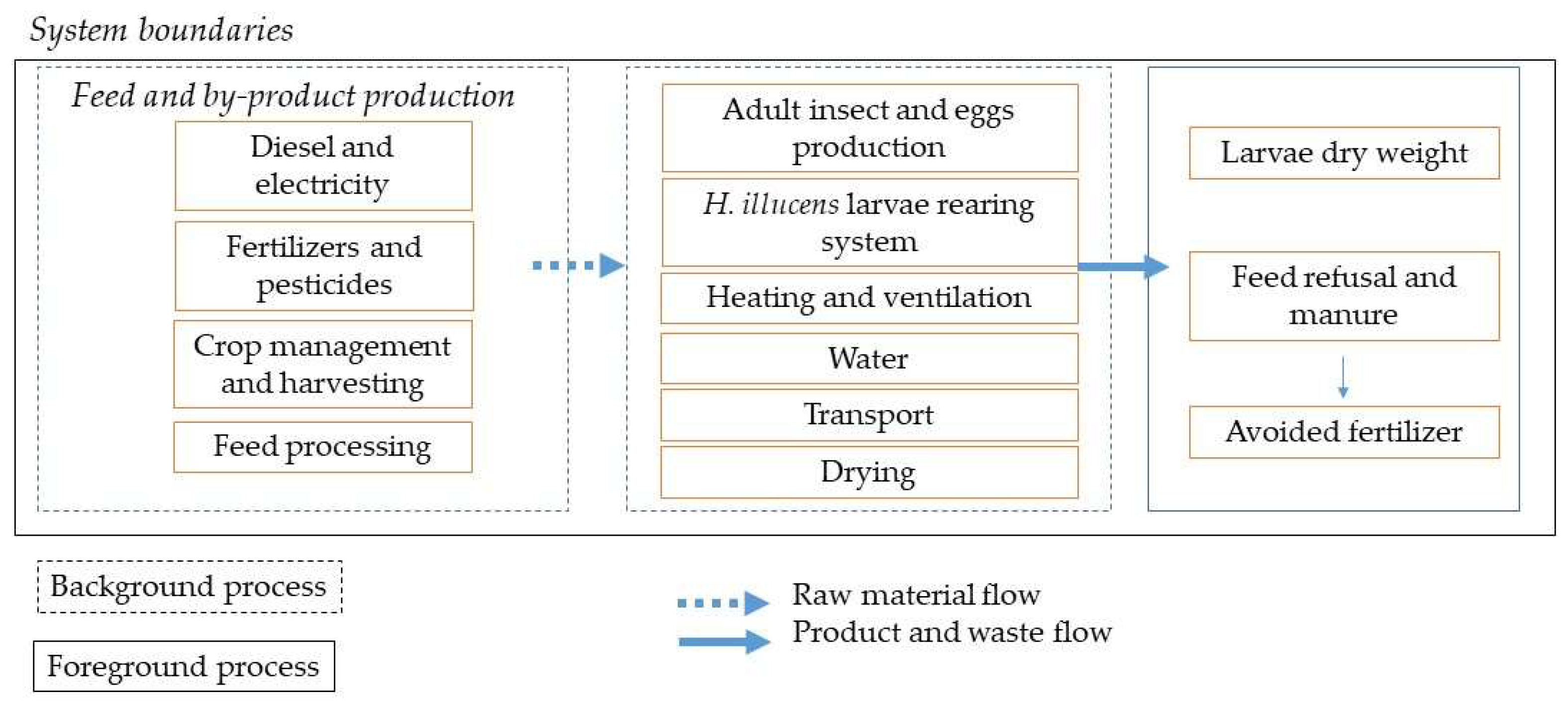
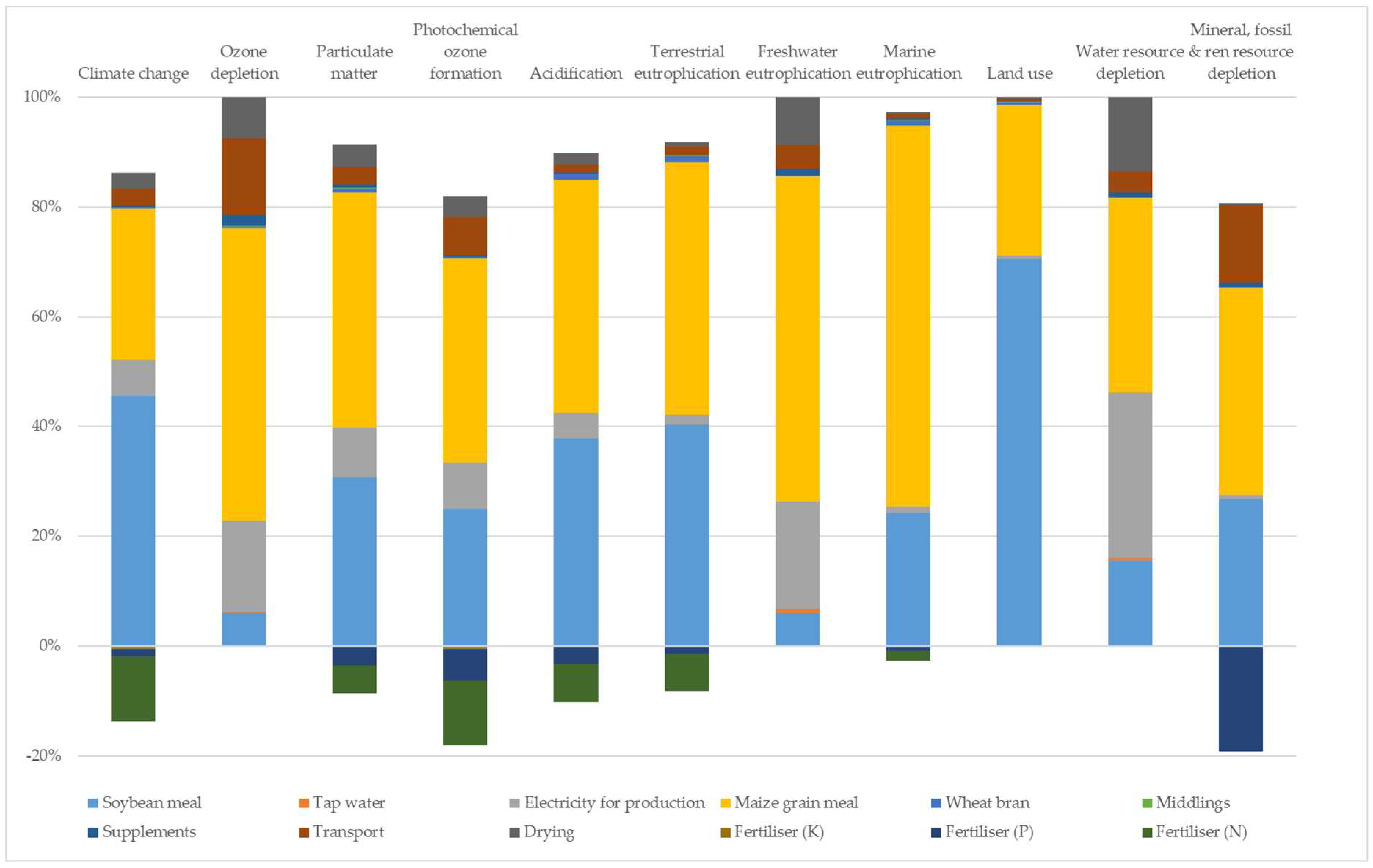
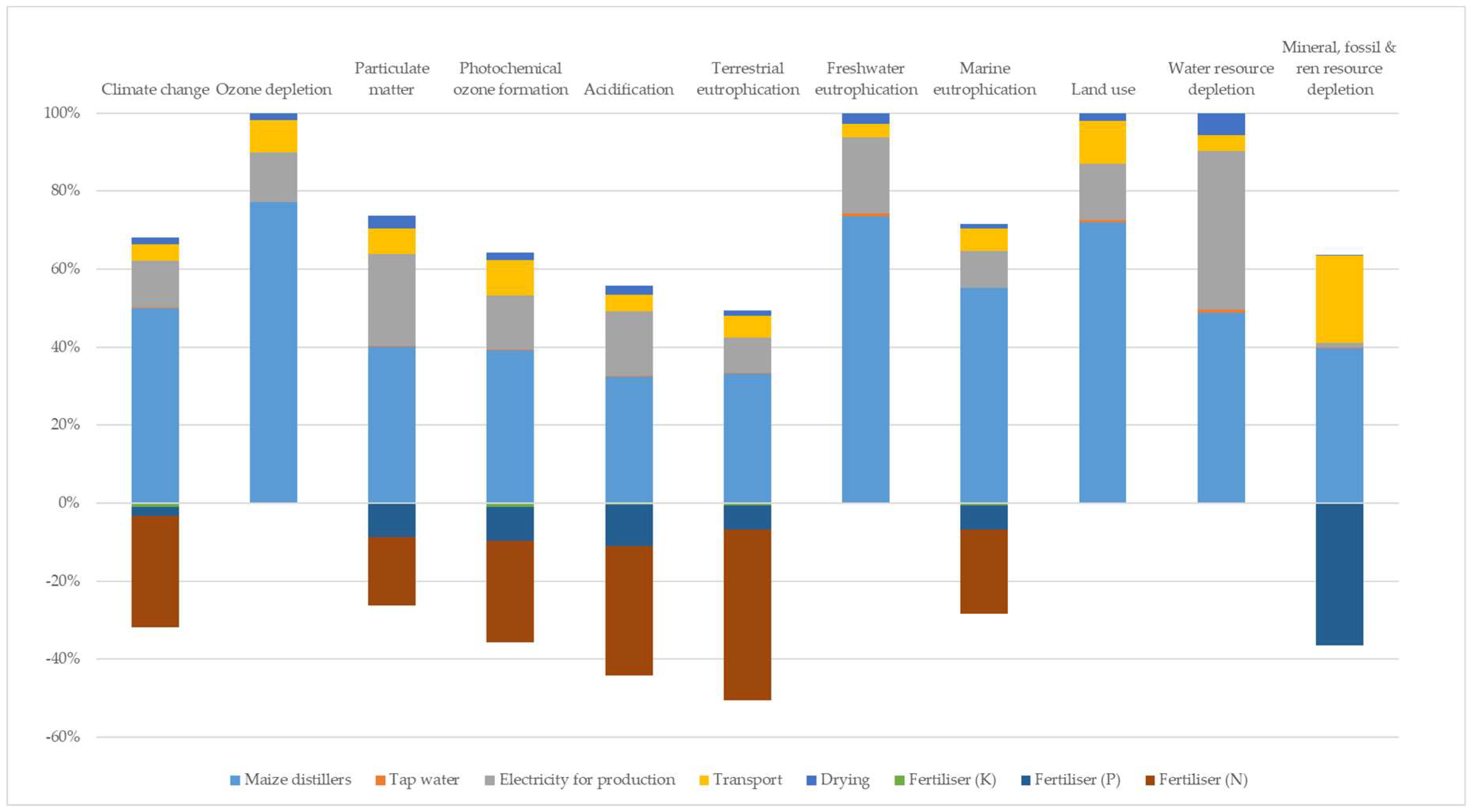
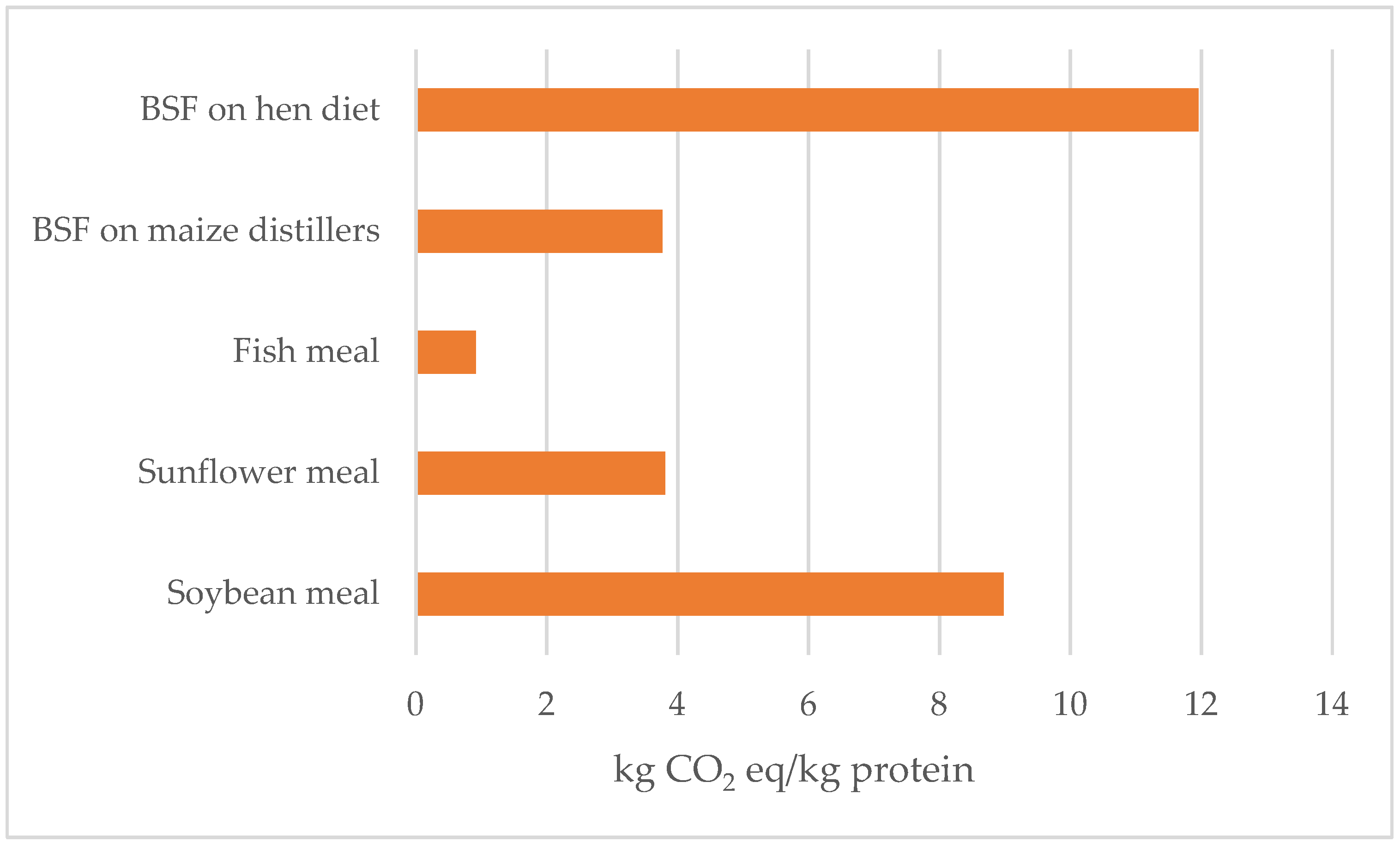
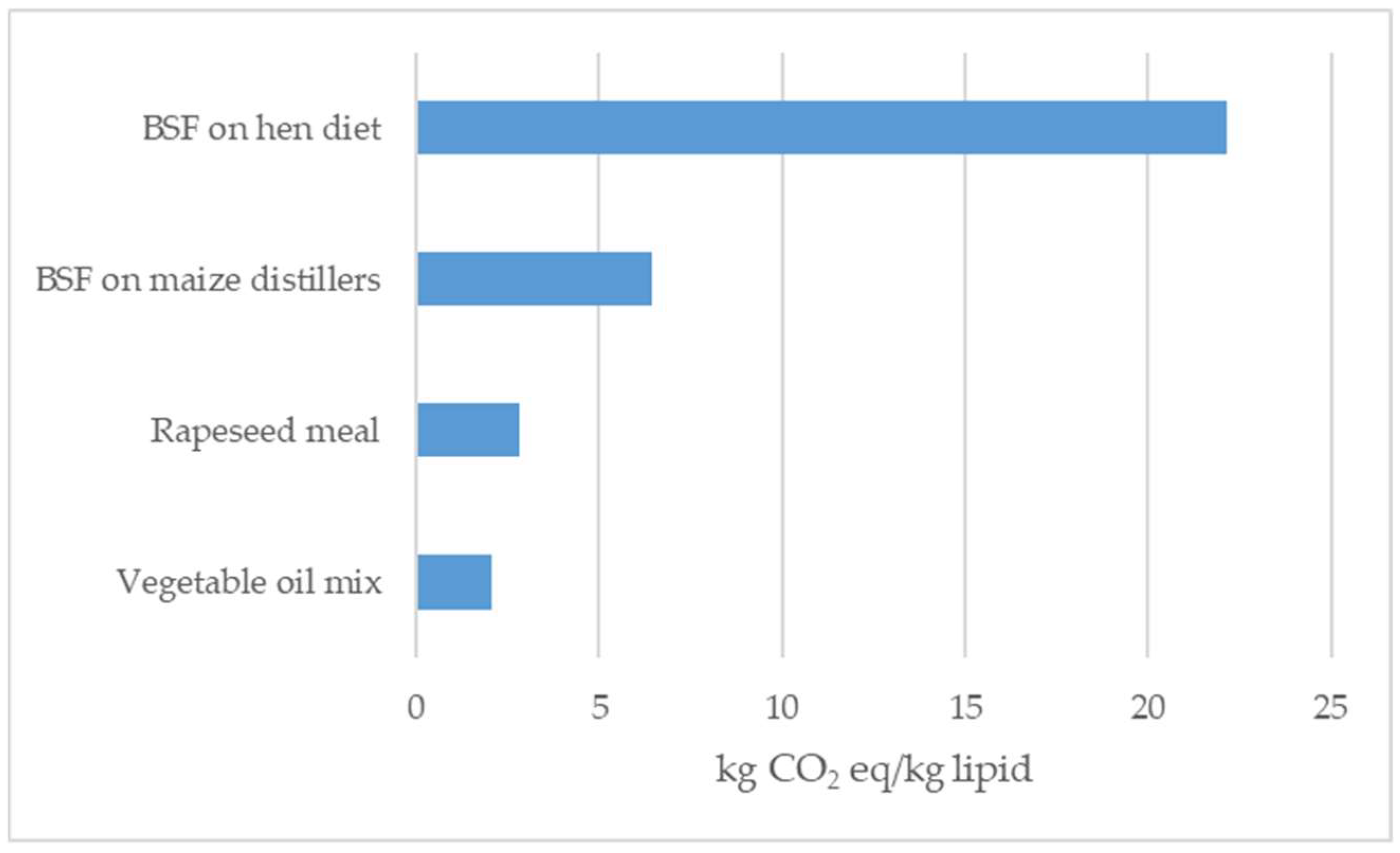
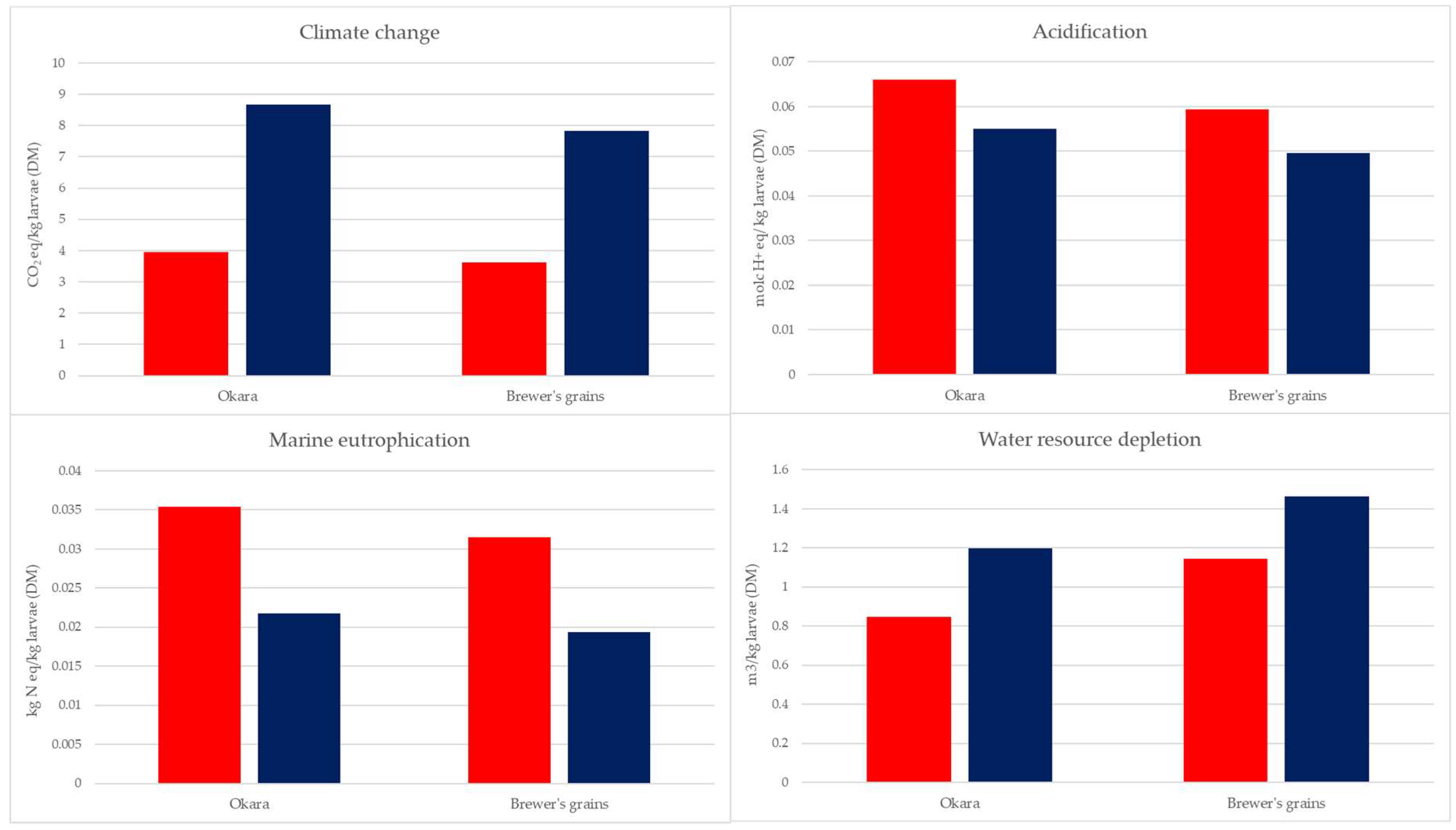
| Hen Diet | Maize Distiller | Okara | Brewer’s Grains | |
|---|---|---|---|---|
| Input | ||||
| Ingested feed, kg of DM | 4.22 | 2.81 | 2.80 | 3.30 |
| Electricity, kWh | 0.81 | 1.00 | 1.40 | 2.08 |
| Tap water, kg | 9.61 | 9.78 | 13.7 | 0 |
| Transport, lorry 16–32 t, km | 200 | 200 | 300 | 100 |
| Drying, 60 °C for 24 h, kWh | 0.363 | 0.1411 | 0.1410 | 0.1413 |
| Output | ||||
| Larvae production, kg of DM | 1 | 1 | 1 | 1 |
| Protein production from larvae, kg protein | 0.48 | 0.51 | 0.50 | 0.53 |
| Lipid production from larvae, kg lipids | 0.26 | 0.30 | 0.32 | 0.25 |
| Feed refusal and manure, kg of DM | 3.056 | 2.757 | 0.583 | 0.850 |
| Experimental Substrates | Dry Matter% on A Fed Basis | Ash | CP | EE | NDF | NFC |
|---|---|---|---|---|---|---|
| Hen diet | 92.1 | 13.5 | 17.0 | 4.00 | 15.7 | 49.8 |
| Okara | 18.3 | 4.13 | 39.2 | 17.2 | 32.0 | 7.47 |
| Maize distillers | 94.9 | 5.40 | 29.5 | 11.1 | 36.7 | 17.3 |
| Brewer’s grains | 15.8 | 4.13 | 15.8 | 2.89 | 53.6 | 11.2 |
| Substrate | Larval Weight (G) (n = 10) (Fresh Weight) | Larval Survival (%) | WRI | ECD | GR |
|---|---|---|---|---|---|
| Hen diet | 2.29 ± 0.20 b | 97.53 ± 1.86 a | 4.46 ± 0.36 b | 0.27 ± 0.02 a | 0.0051 ± 0.0007 b |
| Maize Distillers | 1.97 ± 0.14 b | 73.00 ± 11.92 a | 3.22 ± 0.21 a | 0.27 ± 0.02 a | 0.0056 ± 0.0001 b |
| Okara | 1.38 ± 0.06 a | 98.5 ± 0.84 a | 4.90 ± 0.07 b | 0.36 ± 0.02 b | 0.0021 ± 0.0.000 a |
| Brewer’s grain | 0.98 ± 0.01 a | 95.87 ± 1.51 a | 3.01 ± 0.06 a | 0.25 ± 0.01 a | 0.0014 ± 0.0000 a |
| Experimental Substrates | DM | Ash | CP | EE |
|---|---|---|---|---|
| Hen diet | 38.9 | 11.7 | 52.8 | 25.1 |
| Okara | 37.4 | 5.91 | 51.2 | 31.2 |
| Maize distillers | 38.5 | 4.94 | 53.4 | 29.9 |
| Brewer’s grains | 36.5 | 7.41 | 54.1 | 23.2 |
| Chemical Analysis | Hen Diet | Maize Distillers | Okara | Brewer’s Grains |
|---|---|---|---|---|
| N content in feed refusal and manure, % | 3.35 | 4.94 | 3.52 | 3.26 |
| K content in feed refusal and manure, % | 1.93 | 1.92 | 2.70 | 0.11 |
| P content in feed refusal and manure, % | 1.26 | 1.32 | 0.88 | 0.88 |
| Impact Category | Unit | Hen Diet | Maize Distillers | Okara | Brewer’s Grains |
|---|---|---|---|---|---|
| Climate change | kg CO2 eq | 5.76 | 1.95 | 0.68 | 0.81 |
| Ozone depletion | g CFC−11 eq | 2.76 × 10−7 | 4.47 × 10−7 | 9.61 × 10−8 | 1.41 × 10−7 |
| Particulate matter | g PM2.5 eq | 1.66 | 0.45 | 0.31 | 0.42 |
| Photochemical ozone formation | g NMVOC eq | 10.2 | 3.39 | 1.91 | 2.38 |
| Acidification | molc H+ eq | 0.049 | 0.002 | 0.004 | 0.004 |
| Terrestrial eutrophication | molc N eq | 0.205 | −0.001 | 0.003 | 0.001 |
| Freshwater eutrophication | g P eq | 0.50 | 0.61 | 0.20 | 0.28 |
| Marine eutrophication | g N eq | 37.7 | 2.43 | 0.55 | 0.64 |
| Land use | kg C deficit | 94.7 | 4.92 | 1.25 | 1.79 |
| Water resource depletion | m3 water eq | 1.26 | 1.16 | 0.75 | 1.06 |
| Mineral, fossil, and ren resource depletion | kg Sb eq | 2.95 × 10−5 | 8.06 × 10−6 | −1.34 × 10−7 | −1.17 × 10−6 |
© 2019 by the authors. Licensee MDPI, Basel, Switzerland. This article is an open access article distributed under the terms and conditions of the Creative Commons Attribution (CC BY) license (http://creativecommons.org/licenses/by/4.0/).
Share and Cite
Bava, L.; Jucker, C.; Gislon, G.; Lupi, D.; Savoldelli, S.; Zucali, M.; Colombini, S. Rearing of Hermetia Illucens on Different Organic By-Products: Influence on Growth, Waste Reduction, and Environmental Impact. Animals 2019, 9, 289. https://doi.org/10.3390/ani9060289
Bava L, Jucker C, Gislon G, Lupi D, Savoldelli S, Zucali M, Colombini S. Rearing of Hermetia Illucens on Different Organic By-Products: Influence on Growth, Waste Reduction, and Environmental Impact. Animals. 2019; 9(6):289. https://doi.org/10.3390/ani9060289
Chicago/Turabian StyleBava, Luciana, Costanza Jucker, Giulia Gislon, Daniela Lupi, Sara Savoldelli, Maddalena Zucali, and Stefania Colombini. 2019. "Rearing of Hermetia Illucens on Different Organic By-Products: Influence on Growth, Waste Reduction, and Environmental Impact" Animals 9, no. 6: 289. https://doi.org/10.3390/ani9060289
APA StyleBava, L., Jucker, C., Gislon, G., Lupi, D., Savoldelli, S., Zucali, M., & Colombini, S. (2019). Rearing of Hermetia Illucens on Different Organic By-Products: Influence on Growth, Waste Reduction, and Environmental Impact. Animals, 9(6), 289. https://doi.org/10.3390/ani9060289






